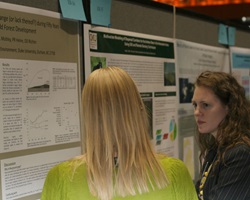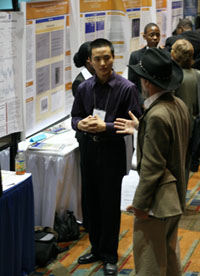Guidelines and Tips for Student Poster Presentations
Student Presenter Registration & Abstract Submission Process
Students who wish to present their research must register for the Conference.
Presentation Acceptance
Presentations are accepted in all areas of science and engineering. Use the drop-down box in the abstract submission to appropriately categorize your presentation.
Completed abstracts will receive approval for presentation shortly after their abstract submission date. An email will be sent to the registrant of the approval or rejection of the abstract. If an abstract is rejected for some reason, monies paid for registration fees will be refunded. Sigma Xi is not, however, responsible for travel or lodging expenses incurred by the registrants. Poster Presentations are accepted as space permits, so register and submit your abstract early.
See examples from 2016.
Guidelines and Space Restrictions for Poster Presentations
-
You will be provided a 4ft x 4ft space of bulletin board to tack your poster presentation.
-
Presentations may not exceed this space, as other posters will be in the space beside yours. Your poster does not have to fill the entire area.
-
You must display and remove your poster according to times indicated in the conference schedule.
-
Internet connections will NOT be guaranteed.
-
Projected presentations are NOT allowed.
-
Presentations using a computer must utilize battery power. Electrical outlets, power-strips and extension cords are not allowed at the poster location. If presenting with a computer, please utilize the computer's battery during presentation. The poster room will not be secure so you will be responsible for keeping your computer with you at all times.
-
The conference schedule will indicate presentation sessions. You should be available and at your poster to respond to questions during these times. Please note that conference attendees may view your poster at times other than the designated presentation sessions so you should keep your poster on display as indicated on the conference program.
Judging
Student poster presenters exhibit their research to be evaluated by preeminent career scientists and engineers. The judges are career researchers that work in academia, industry and government.
Having an abstract accepted for presentation at the Sigma Xi Student Research Conference is an honor. The presentation of student research through a poster and responses to questions by judges will be evaluated against standards common to undergraduate scientific conferences. Judges will provide feedback based on a number of criteria. A sample judging sheet may be viewed for more information.
Judging Categories: Anthropology, Agriculture, Soil & Natural Resources; Cell Biology & Biochemistry; Chemistry; Ecology & Evolutionary Biology; Engineering; Environmental Science; Geo-Sciences; Human Behavioral & Social Sciences; Math & Computer Science; Microbiology & Molecular Biology; Physics & Astronomy; Physiology & Immunology.
Awards
There are four levels of recognition given to poster presentations:
-
Fair - An attempt has been made to meet the standards of a scientific presentation, but has not met the requirements expected for a conference at this level.
the requirements expected for a conference at this level.
-
Good - The basic level of research and presentation for a conference at this level.
-
Excellent - Exceeds the basic level of research and presentation for a conference at this level.
-
Superior - Exceeds the basic level of research and presentation to an exemplary degree; one of the best in the conference in the subject area.
Tips for Student Poster Presentations
While the following tips are offered to student presenters, professional scientists and engineers may find them helpful as well. Look at an example of a poster presentation (PDF).
Title
-
Your title should capture the major aim/conclusion of your research. The title may span the entire top of the 4ft X 4ft board, or may be positioned in the top-center.
-
Lettering for the title should be large enough to be read from several feet away. We recommend using a minimum of 70 pt. font.
Introduction
-
Clearly state the problem or project and the reasons why you are studying it. This information should be contained in the first few sentences.
-
Provide concise and appropriate background discussion of the problem including the significance, scope and limits of your work. Outline what has been established by citing truly pertinent literature. Do not include an overview of marginally relevant literature.
-
State how your work differs from, or is related to, previously published work.
-
How did other scientists' work lead to yours?
-
Make the introduction one or two paragraphs in length.
Materials and Methods
Results
-
Summarize the data collected and the statistical analysis you used, as appropriate. Include only relevant data, but give enough detail to adequately justify your conclusions. Use equations, figures, and tables. Aim for clarity and brevity.
Tables and Figures
-
Use graphs rather than tables to present numerical data. Graphs allow the reader to see trends more easily. If data must be presented in table form, KEEP IT SIMPLE.
-
Leave out any unnecessary details. Studies show that you have only 11 seconds to grab and retain your audience's attention. Display your important points and make them brief.
-
Number tables and figures according to the order in which they appear in the text. Give each table a title. (For example: Figure 1. Species composition).
Discussion/Conclusions
Literature Cited
-
You may choose to provide a list of references cited in the text of the poster. An example is provided below. For more complicated citation formats, use the reference section of any of your primary journal sources. Notice the format that the journal employs and use that method.
Journal article: Author(s). Publication year. Article title. Journal title volume: pages.
Example
Smith, D.C. and J. Van Buskirk. 1995. Phenotypic design, plasticity and ecological performance in two tadpole species. American Naturalist 145:211-233.
Acknowledgements (optional)
In this section, you acknowledge and thank the individuals, departments, programs, and funding resources, which contributed to the research.
General Advice
-
KEEP THE TEXT BRIEF. Blocks of text should not exceed 3 paragraphs. (Most viewers will not read more than that). Present only enough data to support your conclusions, but make sure that there is sufficient information to explain the process.
-
Use a word-processor for all text, including captions. Print on plain white paper.
-
Recommended font sizes for the legibility of major sections:
Title: 85 pt (to be legible at 6 feet, use 30 pt)
Authors: 56 pt
Sub-headings: 36 pt (to be legible at 12 feet, use 60 pt)
Body text: 24 pt
Captions: 18 pt
-
The poster generally should read from left to right, and top to bottom. Numbering the individual panels, or connecting them with arrows is a standard guidance system.
-
Leave some open space in the design. Your audience will appreciate this as it will make your presentation easier to read and understand.
-
Before the poster session, rehearse a brief summary of your project. Conference attendees and judges will want to hear you describe your research and poster. Don't be afraid to point out uncertainties in your work, you may be able to receive valuable feedback and helpful insight from others.
-
It takes time to make a great poster. Allow 2 to 3 days to assemble the pieces, such as photos, graphs and figures, and then allow 2 days to cut all of the boards and physically assemble the poster. TALK WITH YOUR ADVISOR as you go through this process. Make sure he/she approves of your layout and agrees that you have presented all of the important information in the best possible way.
-
You may choose to display your poster on several different sections of colored poster board. To do this, cut the poster board into pieces that fit the size of your text sections. You may choose to use adhesive spray glue or double-sided tape to attach your paper to the backing. Some students prefer one of these methods to using standard white glue, as it reduces wrinkling and bubbling of the paper.
-
Please choose appropriate attire for your attendance and presentation at the conference. The attire expected should be similar to that of an interview.